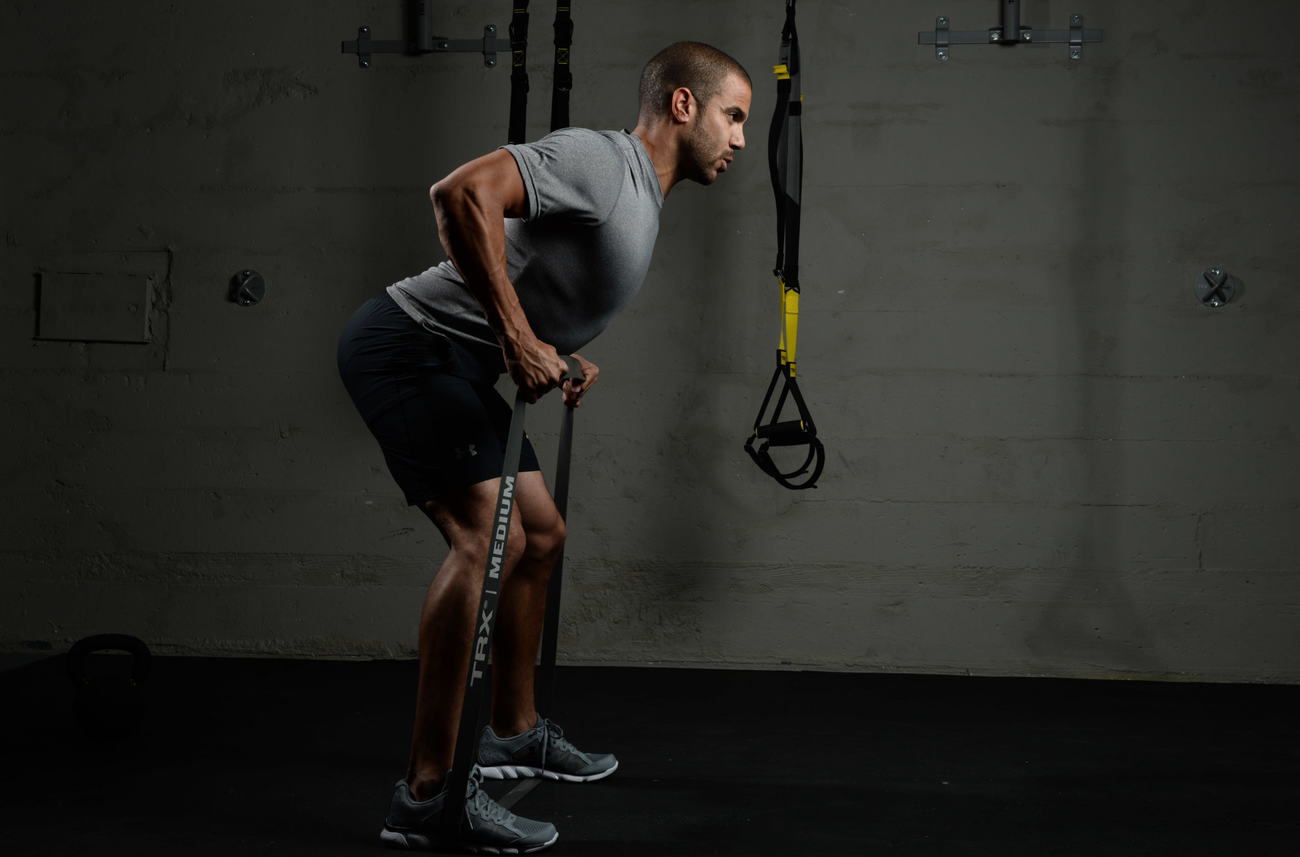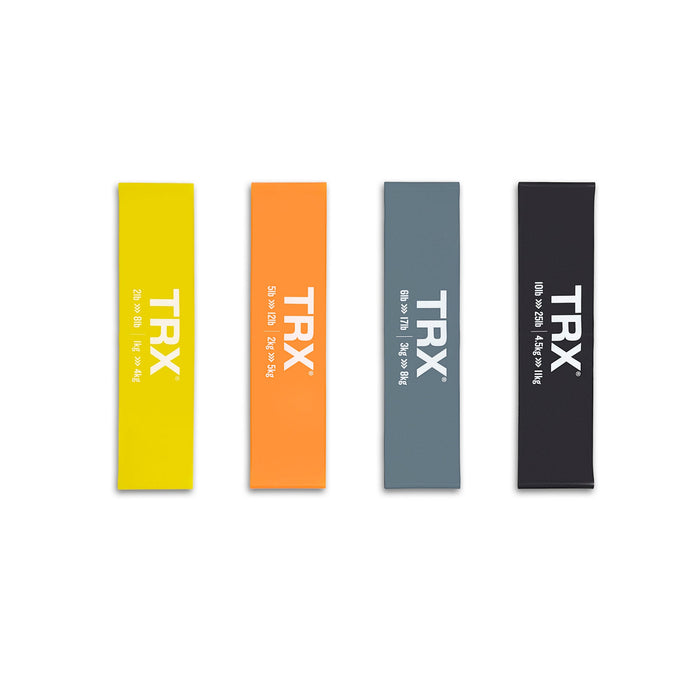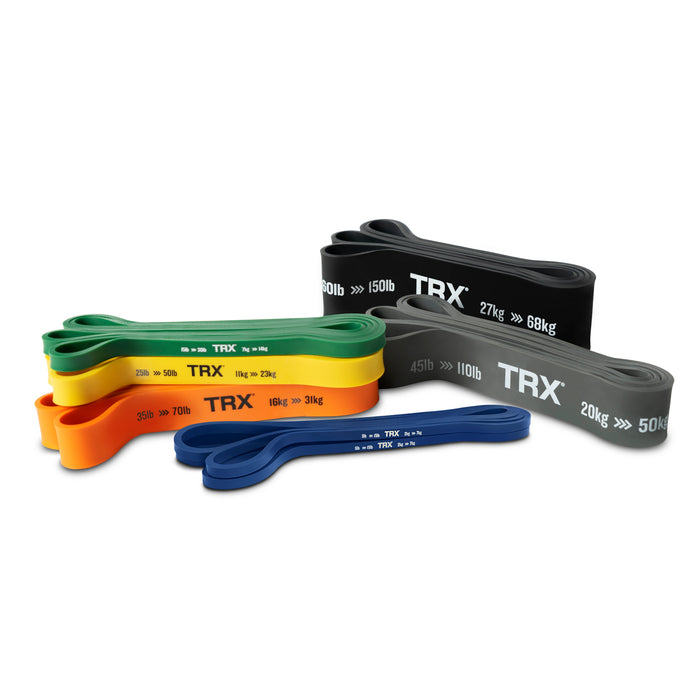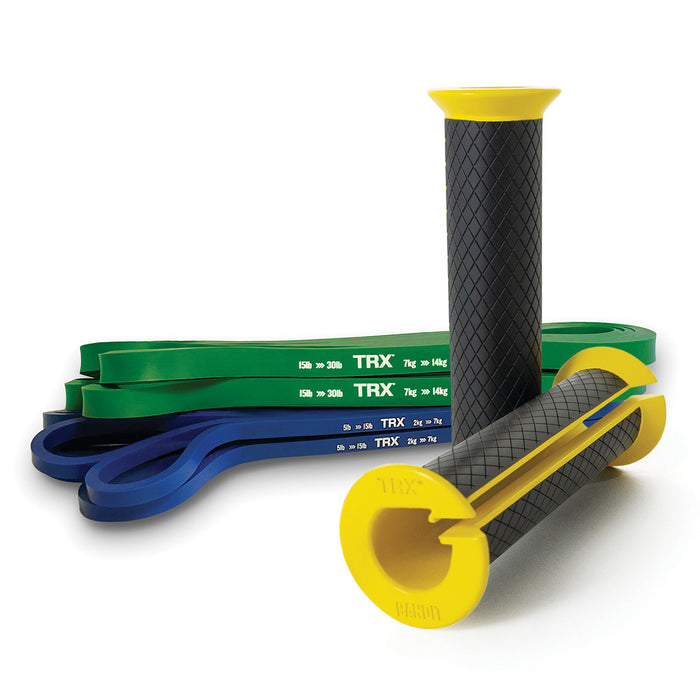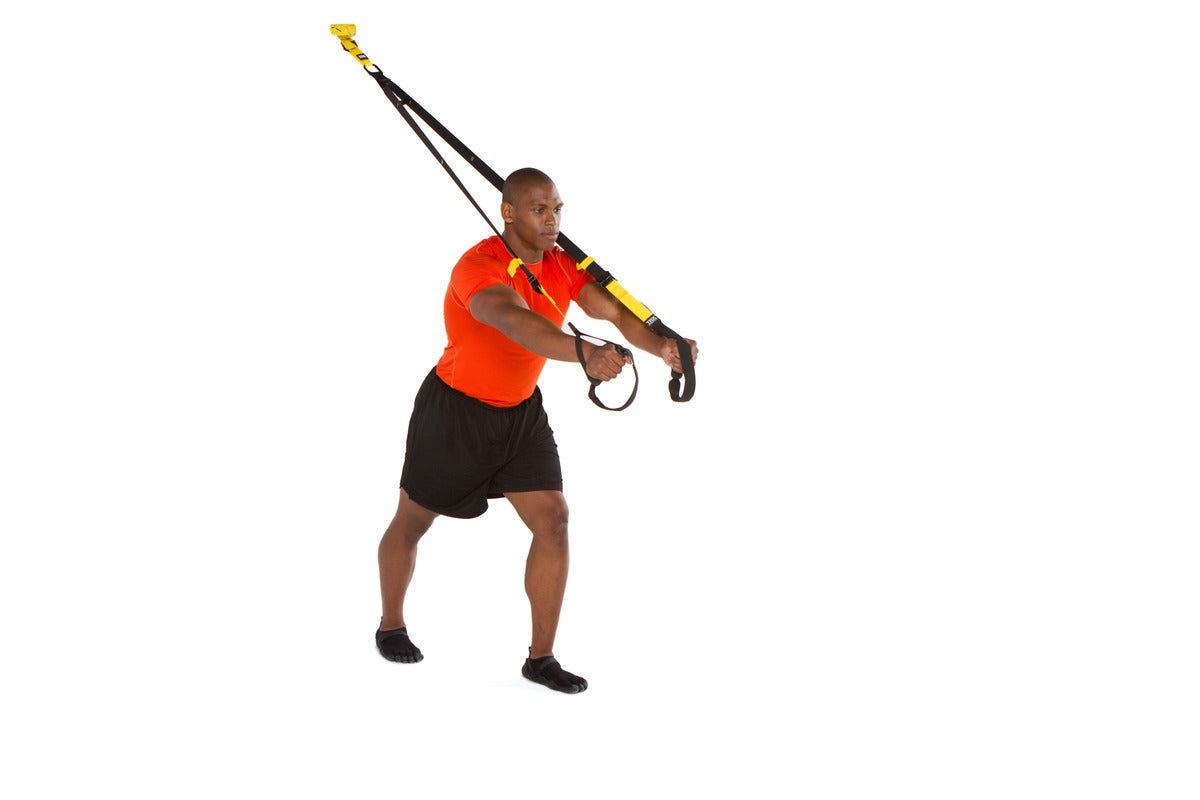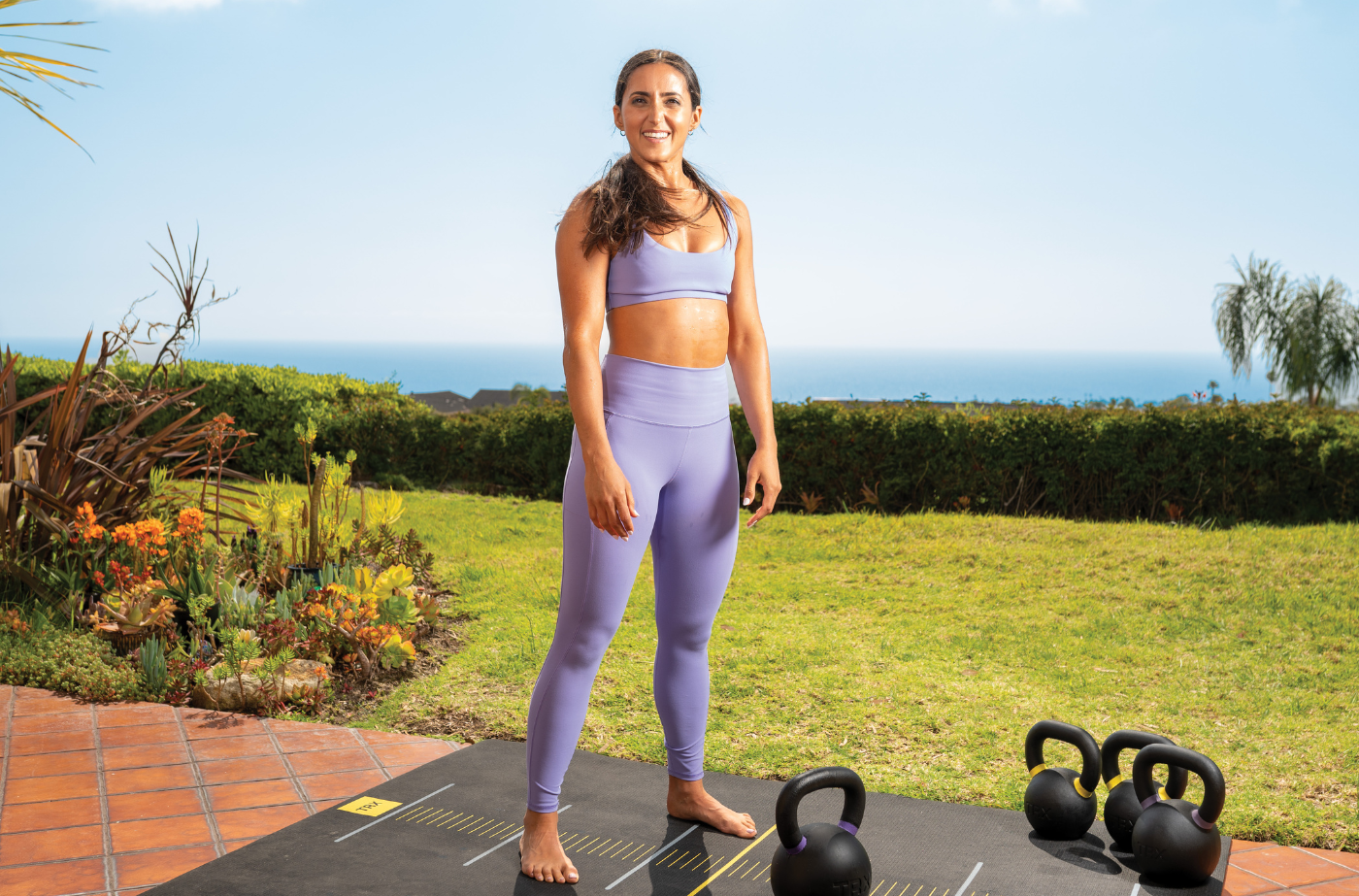Portable, affordable, dynamic, multiplanar, and functional: resistance bands have it all. We’ve put together a killer and effective resistance band chest workout for all levels of fitness. Let’s get started!
What are Resistance Bands?
Originally used for rehab exercises starting in the early 1900s, resistance bands and tubing are a type of resistance equipment that regained popularity as a strength training tool in the 1990s. Not sure which resistance band exercises are right for your fitness level? Take our quick assessment quiz to get a personalized training plan. Resistance bands come in all forms, shapes and sizes: bands with handles, braided bands, mini-looped bands, long-looped strength bands, and of course, our favorite, the TRX Rip Trainer and Bandit handles. Resistance bands tend to be made with lightweight latex rubber, harnessing the benefits of elastic resistance. But don't let the lightweight and flimsy appearance of this fitness tool fool you, resistance bands can really pack a punch.
Can You Get a Good Chest Workout With Resistance Bands?
Multiple studies (1) have shown that training with resistance bands can be just as effective at promoting strength gains as conventional resistance training. Similar to free weights, resistance bands can provide progressive resistance, allow for variable speeds of movement, increase muscle size and strength, and reduce body fat (2). Above and beyond free weights, resistance bands provide variable resistance, meaning the further the band is stretched, the higher the load on the muscle groups being worked. This variable resistance is key to mimicking the strength curve of the muscle, providing higher resistance at the muscle’s strongest point of the exercise. Elastic resistance is also ideal for developing speed and power (3, 4) in movements. A lower force at the beginning of a movement allows for more speed thus greater power development as the band is stretched further. With the added benefits of being versatile, portable, and low-cost, these science-backed resistance band chest exercises should be a staple in your exercise routines.
The Best Resistance Band Chest Exercises
10. Straight-Arm Pulldown
A strong back and shoulder stability are essential to support your chest and shoulders during pressing movements. This exercise works your latissimus dorsi (aka lats) and serratus anterior muscles and helps with scapular stability.
Setup:
- Attach one end of the resistance band to a stable anchor point above your head.
- Make sure the band is securely attached, and the anchor point is stable.
- Stand facing the anchor point.
- Hold the other end of the resistance band with both hands, using a pronated (palms facing down) grip.
-
Your hands should be shoulder-width apart or slightly wider.
Body Position:
- Take a step back to create tension in the resistance band.
- Stand with your feet shoulder-width apart for stability.
-
Keep your core engaged and maintain a slight bend in your knees.
Movement:
- Keep your arms straight throughout the movement.
- Initiate the exercise by pulling the band down towards your thighs while keeping your arms extended.
- Focus on using your lats to perform the movement.
-
Squeeze your shoulder blades together at the bottom of the movement to engage your back muscles fully.
Controlled Return:
- Slowly return your arms to the starting position while maintaining tension in the band.
- Avoid letting the band snap back; control the resistance during both the pulling and releasing phases.
9. Resistance Band Pushup
Adding a resistance band to a traditional push-up is an excellent way to not only add load to the movement but to also match your natural strength curves through the variable resistance of the band. These push-ups can be done at a steady speed to focus on strength, or at a faster speed for developing explosive speed and power.
Setup:
-
Anchor one end of the resistance band to a secure point at chest height. Ensure that the anchor is stable and won't move during the exercise.
Body Position:
- Place your hands on the floor slightly wider than shoulder-width apart.
- Loop the other end of the resistance band around your upper back, just below your shoulder blades.
- Get into a strong, active plank position with your body in a straight line from head to heels.
-
Hold onto the ends of the resistance band with your hands. Make sure the band is snug but not overly tight.
Movement:
- Lower your body toward the ground by bending your elbows. Keep your body in a straight line, and avoid letting your hips sag.
-
Go down until your chest is close to the floor or hovers just above it.
Return:
- Push through your palms to extend your arms and return to the starting position.
- Keep your core engaged throughout the movement.
8. Resistance Band Bench Press
The resistance band bench press is an excellent way to strengthen the chest and triceps while minimizing stress on the shoulder joint.
Setup:
- Anchor the resistance band underneath the bench or another stable surface. Make sure the anchor is secure.
-
If you have a band with handles, hold one handle in each hand. If you have a looped band, position it underneath your upper back on the bench, with one end in each hand.
Body Position
- Sit on the bench with your back straight and firmly planted. Make sure your head, shoulders, and hips are in contact with the bench.
- If using a looped band, ensure it's positioned across your upper back, and hold the ends in each hand.
- Hold the handles or ends of the resistance band with an overhand grip (palms facing away from you).
-
Position your hands at chest level, with your elbows bent at a 90-degree angle.
Movement:
- Press both hands upward, extending your arms fully.
- Squeeze your chest muscles at the top of the movement.
-
Ensure that your wrists are in a neutral position, and your elbows are not locked out.
Return:
- Slowly lower your hands back down to chest level, maintaining control over the resistance band.
- Allow your elbows to bend naturally during the lowering phase.
7. Seated Resistance Band Row
Although this is a pulling exercise, it is ideal for developing proper shoulder stability and movement mechanics that lead to better pressing exercises.
Setup:
- Attach the resistance band securely to your feet.
- Hold one handle, or the end of each loop, in each hand.
- Sit with your back straight and maintain good posture.
Body Position
- Sit tall and proud, with a neutral spine and shoulders down and away from your ears.
-
Extend your arms in front of you, keeping a slight bend in your elbows.
Movement:
- Initiate the rowing movement by pulling your elbows back and squeezing your shoulder blades together.
- Keep your wrists straight, and focus on using your back muscles to perform the row.
- Bring the handles toward your ribcage.
Return:
- Slowly extend your arms back to the starting position, maintaining control over the resistance band.
- Keep tension in the band throughout the entire range of motion.
6. Resistance Band Incline Press
No anchor point? No problem. This simple pressing exercise not only promotes chest strength, but is also effective for shoulder and core stability.
Setup:
- Place the center of your long band under your back foot, firmly securing it to the floor.
- Step forward with the other leg so that your feet are in an offset stance.
Body Position:
- Holding one end of the band in each hand, begin with your hands just above your shoulders.
Movement:
- Maintaining shoulder stability, push forward and up at about a 45 degree angle.
Return:
- Slowly return the band to the starting position.
- If the band is rubbing on your arms, experiment with your angle of press and the angle of lean with your upper body.
5. Resistance Band Cable Flys
A great variation of traditional cable flys, with emphasis on movement at the shoulder joint and bonus core strength and stability.
Setup:
- Attach the resistance band to a stable anchor point. This could be a door anchor, a sturdy pole, or any fixed point at chest height. Make sure it's secure.
Body Position:
- Stand facing away from the anchor point with feet shoulder-width apart.
- Hold the handles in each hand, arms extended straight in front of you, palms facing each other, and elbows slightly bent.
- Take a step forward with one foot to create tension in the band.
Movement:
- Keep a slight bend in your elbows throughout the exercise to avoid joint strain.
- Open your arms in a wide arc, bringing the handles toward the sides of your body, but not past the line of your shoulders.
- Focus on squeezing your chest muscles as you bring your hands together in front of you.
Return:
- With the core engaged, slowly reverse the motion, returning your arms to the starting position.
4. Wide-Stance Low Crossover
The Low Crossover is a simple movement yet quite challenging isolation exercise that targets the chest and anterior shoulders.
Setup:
- Position your feet wide on top of a long resistance band with handles. The wider your feet, the more challenging the exercise!
Body Position:
- Grasp both handles with palms facing forward and a slight bend in each elbow.
- Posture should be tall and proud, with an engaged core and shoulders down and back.
Movement:
- While maintaining a slightly bent elbow, lift the right hand up and across the body so that it ends in line with the center of your chest.
Return:
- While maintaining constant tension in the band, slowly lower and repeat on the other side.
- Avoid any additional movement from the rest of the body.
3. Resistance Band Pullup
Another back exercise to help balance out this list of chest-focused movements. Resistance band pull-ups are a perfect stepping stone to an unassisted pull-up. And for those who can already complete a standard pull-up, adding a band can help increase the volume of pull-ups completed in a working set.
Setup:
- Connect a long loop band to an overhead pull-up bar.
Body Position:
- Stand on an elevated surface, and place one foot into the bottom of the looped band.
- Hands should be in an overhand grip and slightly wider than shoulder width on the pull-up bar.
Movement:
- With a straight and tight body, engage the lats and pull your chin above the bar.
Return:
- Slowly lower to the starting position and repeat.
2. Fencer Crossover Pull
Another exercise designed for shoulder stability, this one will help protect your shoulder joints and emphasize excellent posture.
Setup:
- Select either a low anchor or stand on your long resistance band so that there is tension on the band when held at the starting position.
Body Position:
- Standing sideways to the anchor point, grasp the band with your outside hand, so that it starts low across your body.
Movement:
- Like unsheathing a sword, engage behind the shoulder blade and bend the elbow of the working arm.
- Pull the handle across your body and extend the arm about 45 degrees off of the shoulder.
Return:
- Slowly return the arm to the starting position, never losing tension on the band
- Ensure the rest of the body stays stationary, strong, and stable throughout the movement.
1. Resistance Band Pullover
This exercise not only feels good with a great stretch and range of motion, it also targets multiple muscle groups: pecs, lats, triceps, and the core. The constant tension on the band allows for a greater range of motion than doing this exercise with dumbbells, a kettlebell, or plates.
Setup:
- Anchor your resistance band low to the floor behind your bench or on the floor.
Body Position:
- Lay supine (on your back) on a bench or on the floor.
- Grasp both ends or handles of the band in each hand.
- Begin with the hands directly over your chest, palms facing forward, and elbows slightly bent.
Movement:
- Maintaining a bend in the elbows, slowly lower your hands so that your arms are in line with your ears.
- Pressing into the handles, drive the hands down toward your hips.
Return:
- Slowly return to the starting position while maintaining control and tension in the band.
Try one of our TRX products today:
Sample Resistance Band Chest Workout
This chest workout begins with a warm-up to ensure the shoulders are ready for all of the pushing movements. After the warm-up, select a resistance band for each exercise that allows the final rep of each set to be near impossible. This should be done without compromising form. A few back exercises are woven into the workout to aid in shoulder stability and to allow the chest to recover.
Warm-Up:
Exercise Sets/Reps Rest between sets Notes
|
Seated Resistance Band Row |
2 x 15 |
30 seconds |
Emphasis on proper posture, neutral spine, and engagement behind the shoulder blades. |
|
Straight Arm Pull Down |
2 x 10 |
30 seconds |
Great for core engagement at the beginning of the workout. Keep shoulders down and back and chest open, |
Workout:
Exercise Sets/Reps Rest between sets Notes
|
Resistance Band Push-Up |
2 x 10 |
30 seconds – 1 minute |
Move with speed and power off of the bottom of the push-up. Option to do these from the knees. |
|
Resistance Band Bench Press |
2 x 10 |
30 seconds – 1 minute |
Focus on heavy load. |
|
Resistance Band Pull-Up |
2 x 10 |
30 seconds – 1 minute |
A challenging back exercise and a chance for the chest to recover. |
|
Resistance Band Incline Press |
2 x 10 |
30 seconds – 1 minute |
|
|
Resistance Band Cable Flys |
2 x 10 |
30 seconds – 1 minute |
|
|
Fencer Crossover Pull |
2 x 10 (each side) |
30 seconds |
Another shoulder/back exercise allowing for chest recovery. |
|
Resistance Band Pullover |
2 x 10 |
30 seconds – 1 minute |
|
|
Wide-Stance Low Crossover |
2 x 10 (each side) |
30 seconds |
|

